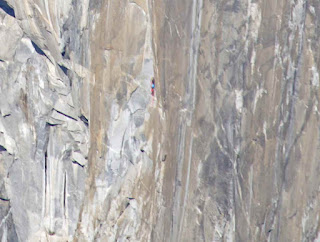Dale Matson
Click On Photographs To Enlarge
 |
| Half Dome With Cloud's Rest To The Left |
This time of year is not optimal for photographing in
Yosemite. There is usually not water in Yosemite and Bridalveil Falls and there
are ordinarily some “let burn” fires going too. The air quality is not good and
there has been little rain to clear the air. Having said that, Yosemite is
still a wonderful place to be and to photograph. There were no clouds for
framing shots but there was a gentle warm breeze even above 8,000’ on Sentinel
Dome.
My friend and former colleague Dave from Fresno Pacific
University is an excellent amateur photographer and came with me. He uses a
full frame Canon and had two lenses with him. He had the 24-105mm f4 kit lens
and a Rokinon 14mm 2.8 ultra wide lens made for the Canon EF mount.
I had my Sony A7RII, a Sony Zeiss 24-70mm f4 native lens and
older model Canon 100-400mm f4.5-5.6. I have a Viltrox Canon EF-NEX II adapter
for this lens. Because I had the Canon adapter, I was also able to use Dave's Rokinon
lens on my Sony. I was disappointed in most of the shots, which were not sharp
when viewed maximum size. My final two photographs are with the Rokinon lens.
While I get my Canon lens information included in the photograph file, I did
not have any information from the Rokinon lens. It is a manual focus lens and I
used my Sony focus peaking.
We went to three locations along Glacier Point Road (I have skied this road in the winter much more than I have ever driven it). We
started at Sentinel Dome, and then went to Washburn Point and finally Glacier
Point itself. Each location gives a different perspective. Even after Labor Day
during the week, parking was packed at Glacier Point. We should have gone there
first and worked our way back to the other two locations. The sun is best here
in the late afternoon but we were back in Fresno by 3pm.
El Capitan
Survey Marker On Sentinel Dome Circa 1905
Face Of El Capitan 400mm
Climber Seen With Cropped 400mm
150mm From Sentinel Dome
Famous Jeffrey Pine Now Obviously Deceased
http://shop.anseladams.com/Jeffrey_Pine_Sentinel_Dome_p/5010114-u.htm
http://shop.anseladams.com/Jeffrey_Pine_Sentinel_Dome_p/5010114-u.htm

Dave
Nevada Falls With Bridge 300mm
Half Dome 400mm
Vernal Falls 400mm
Half Dome And Yosemite Valley 7omm
Mt. Clark 400mm
14mm
14mm
400mm Cropped With Folks On Nose Of Half Dome























































